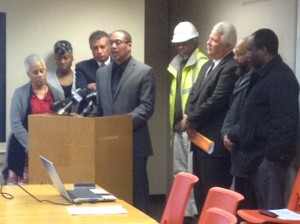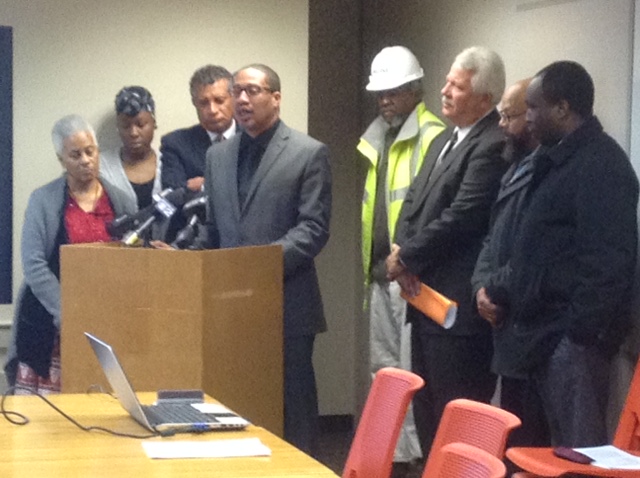
Political empowerment involves not only voting rights, but also issues of economic, personal and community security. For almost 30 years, Pittsburgh-based Black Political Empowerment Project has worked to provide the means to achieve this security to African-American citizens.
Through their office at Freedom Unlimited in the Hill District, B-PEP provides “hope, and a sense of empowerment,” as well as violence prevention and protection through their sister organization, The Greater Pittsburgh Coalition Against Violence (CAV), and economic empowerment via their Corporate Inclusion and Equity Roundtable (CEIR). In addition to encouraging voting and providing enlightenment about political issues, B-PEP has been actively involved in working toward resolving the issue of violence within the community and between communities and other outside parties, providing strategies for reducing gun violence, facilitating safe interaction with law enforcement and serving as a representative for African-American communities in matters of importance.
Monday morning, B-PEP Chairman and Chief Executive Officer Tim Stevens announced that, in preparation for the group’s May anniversary and as a cap to end this year’s Black History Month, “B-PEP is beginning a new piece of history, and a new way to serve our community” by unveiling two new websites: The revamped B-PEP website (b-pep.net/), and a second, separate “sister site” for the CAV (coalitionagainstviolence.net/).
The two web sites are separate, says Stevens, but “everything’s connected. The B-PEP website has civic engagement, Corporate Equity and Inclusion Roundtable, a community calendar, jobs and training. The Coalition Against Violence is its own website. We are looking at a separate website for CEIR as well, but it will all link into each other.”
The sites were created through a collaboration with students in Robert Morris University’s Media Arts classes, under the direction of Professor Letrell Crittenden over a period of just eight weeks.
“From the moment we began to meet with Tim, the students not only helped to design the websites, they did photos for the websites, they did videos for the websites, they helped out with some of the social media aspects of the sites, and also did some of the planning and some of the new logo designs,” says Crittenden. “I said, ‘Here’s a project, here’s the goal, here’s who you are going to meet with. They met with everybody, had phone conversations, and produced this within a period of eight weeks. This is what can happen when you have collaboration between universities and non-profit organizations.”
Crittenden says the project was important to give students the opportunities to engage with diverse populations, but also, “to see what is happening in these communities. This is an example of what we call ‘engaged learning.’ I hope we continue to move forward.”
Both websites are linked to each other to provide the same one-stop location for information, but have added features as well through the students’ collaboration with community members and B-PEP staffers and volunteers. They are intended to be “mobile-friendly,” accessible via tablets, phones and hand-held devices, because, says Crittenden, “particularly for working-class African-Americans, the mobile device is how they access the internet. So we wanted to have something specifically friendly to mobile devices, and they tested everything to make sure that, on a tablet or on a phone, it would be something they could access easily.”
The previously bare-bones B-PEP site now features information about the history of voting rights, additional resources for voter empowerment and a downloadable version of the “You and the Police” brochure created to assist citizens in encounters with the police.
In addition to the newly added videos and photos created mainly by the RMU students, a new “Community Calendar” has also been added, which allows not only B-PEP staff and volunteers to add events, but also permits submissions from other members of the public. Stevens says it is his hope that this will help to not only provide a place to find events, but also to preclude important events from being scheduled simultaneously.
“With this Community Calendar, people can go on our website and see what’s happening in May, or in September, and hopefully say ‘Let’s not schedule our event on that date.’ It’s a community service,” Stevens says.
The website also works with new partners to offer a job trainings and internships tab, featuring job listings from organizations like Vibrant Pittsburgh, ImaginePittsburgh and other partners on one side of the page, and individual listings on the other. Both sides of the page provide information on training opportunities, while a feature on the individual side allows employers to post individual job or training availabilities.
“What we have done is create the opportunity for partnerships, which we expect to be ongoing partnerships, with the Allegheny Conference on Community Development and their ImaginePittsburgh site, literally going into great detail about job opportunities in the region, and Vibrant Pittsburgh, who have been partner and one of our partial funders, to share the inviting opportunities which Pittsburgh is beginning to offer,” Stevens says.
Another important partner in the “Jobs, Training and Internship Opportunities” section is the Builders Guild of Western Pennsylvania.
Jason Fincke, the Executive Director of the Builders Guild, says they are trying to educate the public about opportunities in the construction trades.
“It has always been a challenge to find good applicants for the building trades: People who understand what the criteria is and what the work requires,” Fincke says. “I think by working with B-PEP and their new website it can help us reach that audience in the inner city that perhaps in the past hasn’t really truly understood what construction opportunities are out there.”
“Over the next five to ten years, we are looking for anywhere from 1000 to 1500 apprentices in the 17 building trade unions take in, which is a significant number,” says Fincke. “There are jobs in construction, not just in their own neighborhoods, but we want people to be able to work, for example, at the new petrochemical plant in Beaver County.”
The Builders Guild also will promote its initiative to introduce the trade unions to more men and women from urban areas by introducing them to the wide array of jobs available in construction. The three-times-yearly initiative includes 15-20 men and women, exposing them to those opportunities at the Energy Innovation Center
“It’s more than just carpentry and electricians and plumbers,” Fincke says. “There’s insulators, there’s steamfitters, there’s boilermakers, there’s bricklayers. Seventeen building trade unions all have their own apprenticeship schools, all are tuition-free, and all create family-sustaining career opportunities.”
“B-PEP has been for years, and also, when I was the NAACP President, advocating for the expansion of people of color and women into the trade unions,” Stevens says. “That’s why we came up with the new initiative announced the week before last. But the ongoing commitment to share with our website the trade union training opportunities…”
“We want people of color to go to college and graduate with PhDs,” Stevens says. “But we also want those who may not be college-oriented, but who obviously need training and need jobs and need income, to have that opportunity as well. That’s why the new partnership with the Builders Guild on our website is so important.”
Lois (Toni) McClendon, CAV Administrator and lead writer and editor for all B-PEP publications, announced that the group’s new website will soon feature a third, updated edition of the organization’s Strategies for Change: Building More Peaceful Communities. Two of the newest sections are already accessible on the website.
“We currently have 38 different sections, from Athletes to Youth, about what people can do to help end the violence in the communities as individuals, as agencies, as institutions,” McClendon says. “We have included two new sections in this document, which can be accessed on the website.”
One of the new sections includes information about violence against members of the Lesbian, Gay, Bisexual, Questioning/Queer, Asexual, Intersexual or Transgender community. Some of the focus areas include sexual and intimate partner violence, hate crimes, violence from law enforcement and the justice system, and bullying. Strategies are offered for community members, parents and other family members, schools, law enforcement and social service agencies, providing resources and definitions.
The second newly added piece concerns violence against women and girls. While the original documents offered support and resources for victims of domestic violence, the new sections take the information a step further, recognizing that gender-based violence is found outside of intimate family or partner relationships. From child sexual abuse to campus sexual assault to human trafficking, the document offers resources for victims and those around them.
“This document was a grass-roots effort, so it’s not an academic type document. It’s easily accessible to everyone,” McClendon says. “The new sections address the communities that are sort of on the bottom of the totem pole, but we want to make sure we do whatever we can to end the violence in those communities as well.”
A print version of the third edition will also remain available, with a new cover designed by the RMU students.
Mark Morial, President and Chief Executive Officer of the National Urban League, has called Strategies for Change “one of the most comprehensive in the country,” Stevens says, “and we are adding to it. But it means nothing if no one partners with us to implement these sections. So this is an opportunity to expand the effectiveness of what we do as the Black Political Empowerment Project, as the Greater Pittsburgh Coalition Against Violence, as the Corporate Equity and Inclusion Roundtable.”
Although the new sites are considered a “final product,” Stevens says they will continue to update and add relevant information as time goes on, particularly with the help of B-PEP intern Keonna Gibson, a senior at Carlow University, who has worked closely with the RMU students on the redesigning process.
“She has promised to stay with us as we fine-tune this thing,” Stevens says, allowing Gibson the floor to offer a tour of the new sites, which she and McClendon have already spent six weeks refining, to those present.
B-PEP will continue their Facebook page, facebook.com/Black-Political-Empowerment-Project-B-PEP-402279479147/?fref=ts, and, McClendon says, will soon be on Twitter.
“It’s something new for us,” McClendon says of Twitter. “It still has to be set up. Some of the plans are to periodically tweet sections of the document, so that we can begin to have a conversation about ‘I can do this, my organization can do this,’ and you will click on it and it will take you to that point of the website.”
“That’s a coming attraction,” Stevens says. “As we said, it’s an exciting new moment.”
By Nancy Hart
Twitter@nhart543



































